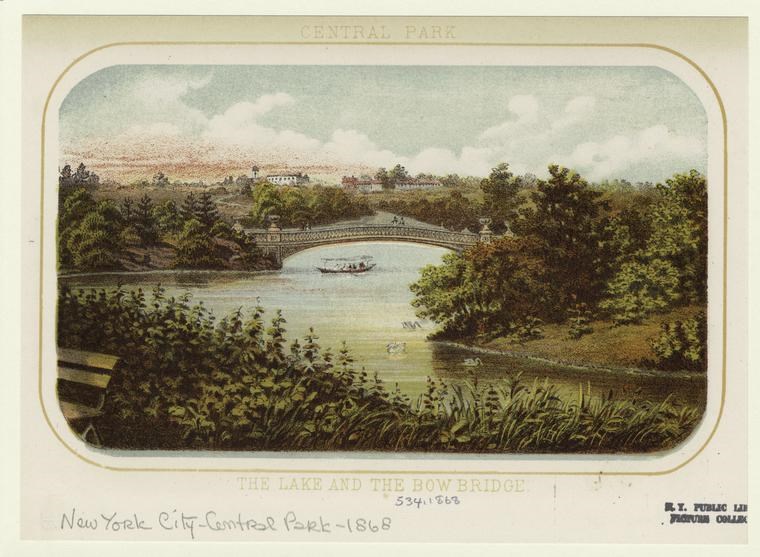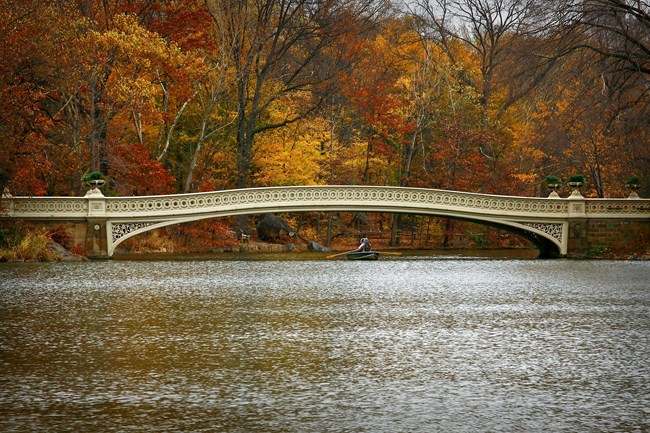Last updated: August 11, 2023
Article
Central Park Rumba: Dancing with Memory
Central Park, located in Manhattan, New York, is the city’s signature natural haven. While many communities have enjoyed Central Park’s green gathering spots, since the 1960s its spaces have been home to rumba dancers and salsa enjoyers who use rumba to connect with each other and with African traditions.

Shannon, Joseph , ed. (1868) Manual of the Corporation of the City of New York, New York City: Common Council, 237. Courtesy of the New York Public Library. No known copyright restrictions.
“Vamos rumbero, que la rumba ya va empezar. Vamos timbero, que la rumba ya va empezar.” - Tito Puente, “Para los rumberos” (1972)
“Our drums are part of us. We speak through our drums, and they speak through us. We are Africa, in all its entirety.” - Humberto Brown [1]
Central Park is host to a combination of cultures that come together around rumba: people dance to music, share folklore and oral histories, and enjoy food. Sunday rumba in the park rose in the 1960s and persisted through repression in the 1990s. It continues to be an expressive community space under the sun.
Rumba is a dance genre that developed in Cuba from a mix of Yoruba, Congo, and Carabal influences from Africa that represent themselves in the yambú, guaguancó, columbia, and jiribilla styles of rumba. Rumba is based on the same clave rhythms essential to salsa music, with a focus on percussion instruments that play interconnected rhythms. Yet, Central Park’s rumba is different from rumba in Havana or Matanzas—rumba in New York’s signature park was a community practice of connection to tradition and one another across lines of class, race, and religion.
“Everyone was going back to their roots, and playing drums in the street and the park was part of that expression, to express your roots and be proud of them.” - Elio Luis Flores Valentin de Hostos [2]
For the Afro Latin diaspora, Central Park has been a place to connect with traditional culture. Specifically, Bethesda Fountain and Bow Bridge around the lake are where people gather every Sunday during the warm months for rumba. Rumba styles are interpreted according to specific African traditional rhythms and movements. This means that dancers move and people interact in specific ways that follow social and cultural protocols.

Photo by Sidvics, Wikimedia Commons, CC BY-SA 4.0
For example, when dancers make certain movements representing Abakuá ancestors, others might know to respond in Carabali or with Abakuá rhythms. Additionally, rumba dancers and musicians know not to mix styles or genres that would cross traditional lines. Rumba is a style where people embody memory and show respect and enjoyment for African tradition and each other by performing together.
In Central Park, dancing rumba brought together people from different backgrounds. Rumba had spread to the barrios of New York in the 1950s via rumberos who migrated from Cuba. By the 1960s, Central Park had become a location where people from various barrios around the park met under the rhythms of rumba. Civil rights gatherings, anti-war demonstrations, and the rise of Young Lords in and around Central Park joined Cubans, Nuyoricans, and African Americans to share in culture, tradition, and activism.
“Rumba represented a perfect place where you could interact racially in an acceptable environment. It was a demilitarized zone for a whole generation that was part of the civil rights movement.” - Rumba dancer Paula Bailan [3]
In particular, as rumberos danced to Tito Puente or listened to Felipe Luciano on the radio, the beats of the drums allowed young Nuyoricans to explore their cultural connections to Africa. Recordings of plena and bomba, traditional Afro Puerto Rican music, were not easily available in the United States. However, many recordings of Cuban rumba were. Rumba became a genre under which Nuyoricans expressed their African heritage.

Photo by Bryan Schorn, Wikimedia Commons, CC BY-SA 3.0
In the 1980s and 90s, the arrival of new Cuban migrants through the Mariel boatlift and balsero immigration changed Central Park rumba. They claimed rumba in this space, especially those who had experienced the Abakuá revival in Cuba. Rumba became more and more popular, drawing crowds of people and media attention in The New York Times and travel guidebooks.
Yet, when Rudy Giuliani became mayor of New York City in 1994, he made efforts to put an end to these Central Park gatherings. A significant part of his “quality-of-life" campaign was “zero-tolerance policing.” This means that people could be targeted as criminals for any signs of social disorder, including making noise in public areas. Disorderly conduct policies allowed police to confiscate drums, and fine and arrest rumberos in Central Park. These incidents paused the use of drums in Central Park rumba for two years, but rumberos continued to perform with bodies, benches, and coolers. The powerful rumba community of Central Park never faltered.
"Even if the police physically take our drums away, our bodies are our percussion. We reproduce rumba with or without the official drum.” - Humberto Brown [4]
Through the civil rights movements of the 60s and 70s, changes in migration through the 80s and 90s, and government policing in the 90s, Central Park has been a place for honoring tradition, intercultural contact, and forming community through rumba. Central Park continues to be a gathering space for rumberos in New York City. New York City is a Certified Local Government.
This article was researched and written by Hermán Luis Chávez, NCPE Intern, Cultural Resources Office of Interpretation and Education.
[1] Berta Jottar, “Central Park Soundscapes: The Rumba Cypher,” The Gotham Center for New York City History, September 6, 2022, https://www.gothamcenter.org/blog/central-park-soundscapes-the-rumba-cypher.
[2] Ibid.
[3] Ibid.
[4] Ibid.
Basáñez Barrio, Endika. “En los confines de la génesis artística exílica y diaspórica hispanocaribeña. La rumba neoyorkina de Central Park: Su origen migratorio y el proceso de desterritorialización pancaribeña y territorialización estadounidense.” imagonautas 10 (2017): 124-144.
Greene, Judith.“Zero Tolerance: A Case Study of Police Policies and Practices in New York City.” Crime & Delinquency 45 no. 2 (1999): 171–187.
Jottar, Berta. “Central Park Soundscapes: The Rumba Cypher.” The Gotham Center for New York City History. September 6, 2022. https://www.gothamcenter.org/blog/central-park-soundscapes-the-rumba-cypher
—. “From Central Park, Rumba with Love.” Voices (New York Folklore Society) 37, no. 1-2 (2011): 24–31.
—. “The Acoustic Body: Rumba Guarapachanguera and Abakuá Sociality in Central Park.” Latin American Music Review 30, no. 1 (2009): 1–24.
